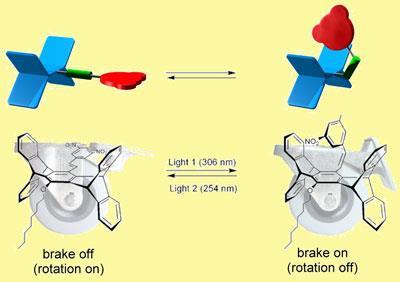Light-activated molecular brake adds stopping power to spinning nanomachines
Chemists in Taiwan have developed a nanomachine fitted with light-triggered molecular brakes, which can stop nanoscale propellers or wheels from spinning.
The ’nanobrake’ is applied by a specific wavelength of light - and then released using a different wavelength. Although other forms of molecular brake have been designed, this is the first time that light has been used as a remote trigger.
’Using light allows our machinery to be clean, fast, and remotely-accessible,’ says Jye-Shane Yang, the leader of the research team at National Taiwan University. ’Our brake also has unprecedented stopping power - we have shown that it is capable of reducing rates of rotation by one billion times.’

The team demonstrated the potential for their nanobrake - a bulky 3,5-dinitrophenyl group attached to a carbon-carbon double bond - by attaching it to a freely-rotating four-bladed pentiptycene molecule. Light can trigger the double bond to photo-isomerise, switching between cis and trans. When double bond is in the trans configuration the pentiptycene propeller can spin freely; but when switched to the cis isomer the bulky phenyl group prevents effective rotation.
Yang envisages that nanobrakes like this could be fitting onto many spinning or rotating nano-scale systems - such as in controlling the movement of "nanocars" or designing extremely sensitive accelerometers to detect motion.
’This is an interesting solution-based method to stop rotation by inserting steric hindrance,’ says James Tour at Rice University in Houston, Texas. Tour designed the original nanocar back in 2006 - an H-shaped carbon chassis with four fullerene buckyball wheels.
’But the real challenges are still ahead,’ Tour continues. ’This technology first needs to be mounted on a surface and then used to perform useful work - for example to trigger a lever or switch that can affect a macroscopic system.’
Lewis Brindley
Enjoy this story? Spread the word using the ’tools’ menu on the left.
References
J-S Yang et al, Org. Lett., 2008. DOI: 10.1021/ol800689a






No comments yet